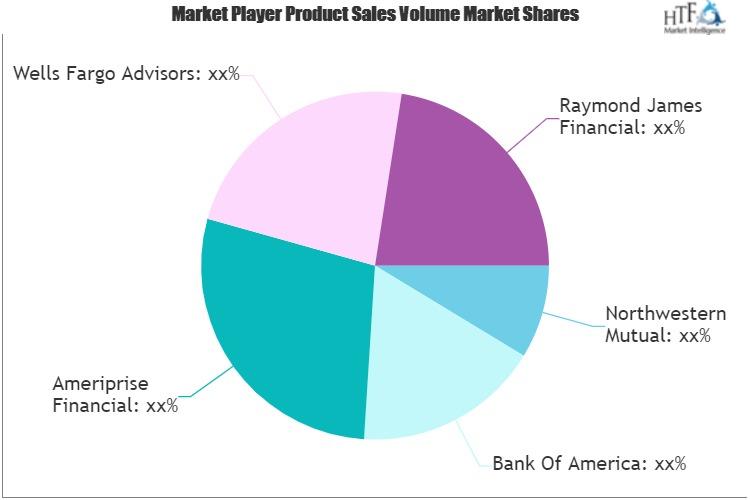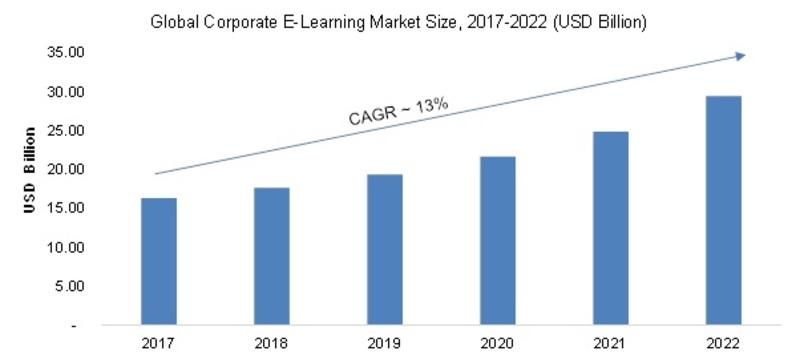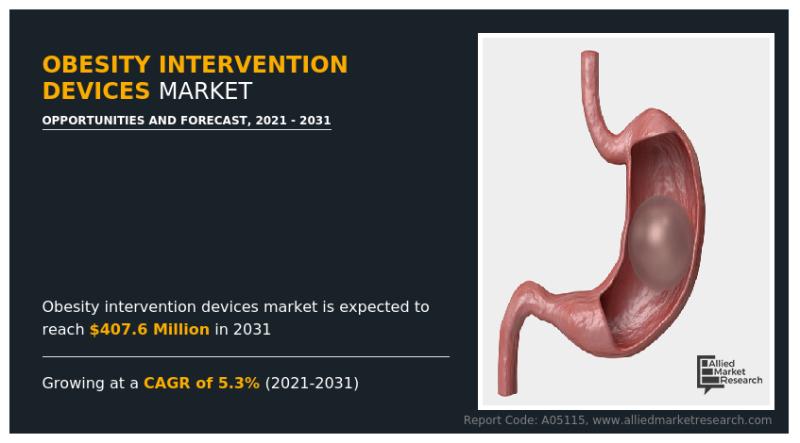Press release
Obesity intervention devices market | $407.6 million | Growing at a CAGR of 5.3% from 2024 to 2031
𝐓𝐡𝐞 𝐨𝐛𝐞𝐬𝐢𝐭𝐲 𝐢𝐧𝐭𝐞𝐫𝐯𝐞𝐧𝐭𝐢𝐨𝐧 𝐝𝐞𝐯𝐢𝐜𝐞𝐬 𝐦𝐚𝐫𝐤𝐞𝐭 𝐞𝐱𝐩𝐞𝐫𝐢𝐞𝐧𝐜𝐞𝐝 𝐫𝐞𝐦𝐚𝐫𝐤𝐚𝐛𝐥𝐞 𝐠𝐫𝐨𝐰𝐭𝐡 𝐢𝐧 𝐫𝐞𝐜𝐞𝐧𝐭 𝐲𝐞𝐚𝐫𝐬, 𝐰𝐢𝐭𝐡 𝐚 𝐯𝐚𝐥𝐮𝐚𝐭𝐢𝐨𝐧 𝐨𝐟 $243.2 𝐦𝐢𝐥𝐥𝐢𝐨𝐧 𝐢𝐧 2021. 𝐓𝐡𝐢𝐬 𝐮𝐩𝐰𝐚𝐫𝐝 𝐭𝐫𝐚𝐣𝐞𝐜𝐭𝐨𝐫𝐲 𝐢𝐬 𝐞𝐱𝐩𝐞𝐜𝐭𝐞𝐝 𝐭𝐨 𝐜𝐨𝐧𝐭𝐢𝐧𝐮𝐞, 𝐩𝐫𝐨𝐩𝐞𝐥𝐥𝐢𝐧𝐠 𝐭𝐡𝐞 𝐦𝐚𝐫𝐤𝐞𝐭 𝐭𝐨 𝐫𝐞𝐚𝐜𝐡 $407.6 𝐦𝐢𝐥𝐥𝐢𝐨𝐧 𝐛𝐲 2031. 𝐓𝐡𝐞 𝐜𝐨𝐦𝐩𝐨𝐮𝐧𝐝 𝐚𝐧𝐧𝐮𝐚𝐥 𝐠𝐫𝐨𝐰𝐭𝐡 𝐫𝐚𝐭𝐞 (𝐂𝐀𝐆𝐑) 𝐟𝐨𝐫 𝐭𝐡𝐞 𝐩𝐞𝐫𝐢𝐨𝐝 𝐛𝐞𝐭𝐰𝐞𝐞𝐧 2022 𝐚𝐧𝐝 2031 𝐢𝐬 𝐩𝐫𝐨𝐣𝐞𝐜𝐭𝐞𝐝 𝐭𝐨 𝐛𝐞 5.3%.
Obesity intervention devices have emerged as a promising solution to address the global epidemic of obesity. These medical tools are specifically designed to facilitate weight reduction by lowering caloric intake or modifying the body's food processing mechanisms. Notably, the approval of an obesity intervention device is often based on its ability to improve or even resolve type 2 diabetes, highlighting the significant impact these devices can have on overall health.
𝐑𝐞𝐪𝐮𝐞𝐬𝐭 𝐑𝐞𝐩𝐨𝐫𝐭 𝐒𝐚𝐦𝐩𝐥𝐞: https://www.alliedmarketresearch.com/request-sample/5480
Key Market Players
𝐀𝐩𝐨𝐥𝐥𝐨 𝐄𝐧𝐝𝐨𝐬𝐮𝐫𝐠𝐞𝐫𝐲, 𝐂𝐨𝐮𝐬𝐢𝐧 𝐒𝐮𝐫𝐠𝐞𝐫𝐲, 𝐒𝐩𝐚𝐭𝐳 𝐅𝐆𝐈𝐀 𝐈𝐧𝐜, 𝐆𝐈 𝐃𝐲𝐧𝐚𝐦𝐢𝐜𝐬, 𝐀𝐛𝐛𝐯𝐢𝐞 𝐈𝐧𝐜 (𝐀𝐥𝐥𝐞𝐫𝐠𝐚𝐧), 𝐄𝐧𝐝𝐚𝐥𝐢𝐬 𝐋𝐚𝐛𝐨𝐫𝐚𝐭𝐨𝐢𝐫𝐞, 𝐀𝐥𝐥𝐮𝐫𝐢𝐨𝐧 𝐓𝐞𝐜𝐡𝐧𝐨𝐥𝐨𝐠𝐢𝐞𝐬, 𝐈𝐧𝐜., 𝐀.𝐌.𝐈. 𝐆𝐦𝐛𝐇, 𝐑𝐞𝐒𝐡𝐚𝐩𝐞 𝐋𝐢𝐟𝐞𝐬𝐜𝐢𝐞𝐧𝐜𝐞𝐬 𝐈𝐧𝐜, 𝐉𝐨𝐡𝐧𝐬𝐨𝐧 & 𝐉𝐨𝐡𝐧𝐬𝐨𝐧
𝐓𝐡𝐞 𝐨𝐛𝐞𝐬𝐢𝐭𝐲 𝐢𝐧𝐭𝐞𝐫𝐯𝐞𝐧𝐭𝐢𝐨𝐧 𝐝𝐞𝐯𝐢𝐜𝐞𝐬 𝐦𝐚𝐫𝐤𝐞𝐭 𝐞𝐧𝐜𝐨𝐦𝐩𝐚𝐬𝐬𝐞𝐬 𝐚 𝐫𝐚𝐧𝐠𝐞 𝐨𝐟 𝐝𝐞𝐯𝐢𝐜𝐞𝐬 𝐚𝐢𝐦𝐞𝐝 𝐚𝐭 𝐦𝐚𝐧𝐚𝐠𝐢𝐧𝐠 𝐚𝐧𝐝 𝐭𝐫𝐞𝐚𝐭𝐢𝐧𝐠 𝐨𝐛𝐞𝐬𝐢𝐭𝐲. 𝐋𝐞𝐭'𝐬 𝐝𝐞𝐥𝐯𝐞 𝐢𝐧𝐭𝐨 𝐞𝐚𝐜𝐡 𝐝𝐞𝐯𝐢𝐜𝐞 𝐜𝐚𝐭𝐞𝐠𝐨𝐫𝐲 𝐚𝐧𝐝 𝐞𝐱𝐩𝐥𝐨𝐫𝐞 𝐭𝐡𝐞 𝐦𝐚𝐫𝐤𝐞𝐭 𝐢𝐧 𝐝𝐢𝐟𝐟𝐞𝐫𝐞𝐧𝐭 𝐫𝐞𝐠𝐢𝐨𝐧𝐬 𝐚𝐧𝐝 𝐞𝐧𝐝-𝐮𝐬𝐞𝐫 𝐬𝐞𝐠𝐦𝐞𝐧𝐭𝐬:
1. Gastric Bands: Gastric bands are adjustable silicone bands placed around the upper part of the stomach. These bands create a small pouch that limits food intake, promoting weight loss. Gastric bands offer a reversible and less invasive alternative to other surgical procedures for weight management.
2. Gastric Balloon: Gastric balloons are temporary devices that are inserted into the stomach endoscopically. They occupy space within the stomach, leading to feelings of fullness and reduced food intake. Gastric balloons are typically used as a short-term solution for weight loss and are often part of a comprehensive weight management program.
3. Gastric Stimulation System: Gastric stimulation systems, also known as gastric pacemakers, use electrical stimulation to modulate the nerves in the stomach. These devices help regulate hunger and satiety signals, assisting individuals in controlling their food intake. Gastric stimulation systems are often implanted surgically and can be programmed to suit individual needs.
The obesity intervention devices market can be segmented based on end users and regions:
End Users:
1. Hospitals: Obesity intervention devices are commonly used in hospitals, where healthcare professionals have the expertise to perform procedures and manage patients' weight loss journeys. Hospitals provide comprehensive care and support for individuals seeking obesity interventions.
2. Clinics: Obesity intervention devices are also utilized in specialized clinics that focus on weight management and provide non-surgical interventions. These clinics may offer a range of services, including dietary counseling, behavioral therapy, and the use of obesity intervention devices as part of a multidisciplinary approach to weight management.
Regions:
1. North America: This region comprises the United States, Canada, and Mexico. North America has a significant market for obesity intervention devices due to the high prevalence of obesity and a growing emphasis on weight management. Technological advancements, favorable reimbursement policies, and an increasing awareness of the health risks associated with obesity contribute to the market's growth in this region.
2. Europe: The European market for obesity intervention devices includes countries such as Germany, France, the United Kingdom, Italy, Spain, and the rest of Europe. Europe has a well-established healthcare infrastructure and is witnessing a rise in obesity rates. Increasing investments in healthcare, favorable government initiatives, and the availability of advanced medical devices contribute to the market's growth in this region.
3. Asia-Pacific: The Asia-Pacific region includes countries like Japan, China, India, Australia, South Korea, and the rest of Asia-Pacific. With the growing prevalence of obesity and a rising focus on healthcare, the demand for obesity intervention devices is increasing in this region. Rapid urbanization, sedentary lifestyles, and increasing disposable income are driving factors for market growth in Asia-Pacific.
4. LAMEA: LAMEA stands for Latin America, Middle East, and Africa. This region comprises countries such as Brazil, Saudi Arabia, South Africa, and the rest of LAMEA. The market for obesity intervention devices is growing in LAMEA due to increasing awareness of the health consequences of obesity and a rising demand for effective weight management solutions.
𝐅𝐑𝐄𝐐𝐔𝐄𝐍𝐓𝐋𝐘 𝐀𝐒𝐊𝐄𝐃 𝐐𝐔𝐄𝐒𝐓𝐈𝐎𝐍𝐒?
1. What are the key factors driving the growth of the obesity intervention devices market?
2. What are the major challenges faced by manufacturers in the obesity intervention devices market?
3. How does the regulatory landscape impact the development and commercialization of obesity intervention devices?
4. What are the emerging trends in obesity intervention devices, and how are they shaping the market?
5. How are technological advancements, such as artificial intelligence and data analytics, being integrated into obesity intervention devices?
6. What are the most commonly used surgical and non-surgical obesity intervention devices, and how do they differ in terms of effectiveness and patient outcomes?
7. How is the market for obesity intervention devices segmented based on device type, end user, and geography?
8. What are the potential growth opportunities for manufacturers in untapped markets within the obesity intervention devices industry?
9. What are the current reimbursement policies and insurance coverage options for obesity intervention devices, and how do they impact market growth?
10. How do healthcare providers and clinicians evaluate the cost-effectiveness and long-term benefits of different obesity intervention devices when making treatment decisions for patients?
𝐏𝐫𝐨𝐜𝐮𝐫𝐞 𝐂𝐨𝐦𝐩𝐥𝐞𝐭𝐞 𝐑𝐞𝐩𝐨𝐫𝐭 (297 𝐏𝐚𝐠𝐞𝐬 𝐏𝐃𝐅 𝐰𝐢𝐭𝐡 𝐈𝐧𝐬𝐢𝐠𝐡𝐭𝐬, 𝐂𝐡𝐚𝐫𝐭𝐬, 𝐓𝐚𝐛𝐥𝐞𝐬, 𝐚𝐧𝐝 𝐅𝐢𝐠𝐮𝐫𝐞𝐬)https://www.alliedmarketresearch.com/obesity-intervention-devices-market/purchase-options
Contact:
David Correa
1209 Orange Street,
Corporation Trust Center,
Wilmington, New Castle,
Delaware 19801 USA.
Int'l: +1-503-894-6022
Toll Free: +1-800-792-5285
Fax: +1-800-792-5285
help@alliedmarketresearch.com
Web:https://www.alliedmarketresearch.com
About Us:
Allied Market Research (AMR) is a full-service market research and business-consulting wing of Allied Analytics LLP based in Wilmington, Delaware. Allied Market Research provides global enterprises as well as medium and small businesses with unmatched quality of "Market Research Reports" and "Business Intelligence Solutions." AMR has a targeted view to provide business insights and consulting to assist its clients to make strategic business decisions and achieve sustainable growth in their respective market domain.
We are in professional corporate relations with various companies, and this helps us in digging out market data that helps us generate accurate research data tables and confirms utmost accuracy in our market forecasting. Each and every data presented in the reports published by us is extracted through primary interviews with top officials from leading companies of domain concerned. Our secondary data procurement methodology includes deep online and offline research and discussion with knowledgeable professionals and analysts in the industry.
Obesity intervention devices have emerged as a promising solution to address the global epidemic of obesity. These medical tools are specifically designed to facilitate weight reduction by lowering caloric intake or modifying the body's food processing mechanisms. Notably, the approval of an obesity intervention device is often based on its ability to improve or even resolve type 2 diabetes, highlighting the significant impact these devices can have on overall health.
𝐑𝐞𝐪𝐮𝐞𝐬𝐭 𝐑𝐞𝐩𝐨𝐫𝐭 𝐒𝐚𝐦𝐩𝐥𝐞: https://www.alliedmarketresearch.com/request-sample/5480
Key Market Players
𝐀𝐩𝐨𝐥𝐥𝐨 𝐄𝐧𝐝𝐨𝐬𝐮𝐫𝐠𝐞𝐫𝐲, 𝐂𝐨𝐮𝐬𝐢𝐧 𝐒𝐮𝐫𝐠𝐞𝐫𝐲, 𝐒𝐩𝐚𝐭𝐳 𝐅𝐆𝐈𝐀 𝐈𝐧𝐜, 𝐆𝐈 𝐃𝐲𝐧𝐚𝐦𝐢𝐜𝐬, 𝐀𝐛𝐛𝐯𝐢𝐞 𝐈𝐧𝐜 (𝐀𝐥𝐥𝐞𝐫𝐠𝐚𝐧), 𝐄𝐧𝐝𝐚𝐥𝐢𝐬 𝐋𝐚𝐛𝐨𝐫𝐚𝐭𝐨𝐢𝐫𝐞, 𝐀𝐥𝐥𝐮𝐫𝐢𝐨𝐧 𝐓𝐞𝐜𝐡𝐧𝐨𝐥𝐨𝐠𝐢𝐞𝐬, 𝐈𝐧𝐜., 𝐀.𝐌.𝐈. 𝐆𝐦𝐛𝐇, 𝐑𝐞𝐒𝐡𝐚𝐩𝐞 𝐋𝐢𝐟𝐞𝐬𝐜𝐢𝐞𝐧𝐜𝐞𝐬 𝐈𝐧𝐜, 𝐉𝐨𝐡𝐧𝐬𝐨𝐧 & 𝐉𝐨𝐡𝐧𝐬𝐨𝐧
𝐓𝐡𝐞 𝐨𝐛𝐞𝐬𝐢𝐭𝐲 𝐢𝐧𝐭𝐞𝐫𝐯𝐞𝐧𝐭𝐢𝐨𝐧 𝐝𝐞𝐯𝐢𝐜𝐞𝐬 𝐦𝐚𝐫𝐤𝐞𝐭 𝐞𝐧𝐜𝐨𝐦𝐩𝐚𝐬𝐬𝐞𝐬 𝐚 𝐫𝐚𝐧𝐠𝐞 𝐨𝐟 𝐝𝐞𝐯𝐢𝐜𝐞𝐬 𝐚𝐢𝐦𝐞𝐝 𝐚𝐭 𝐦𝐚𝐧𝐚𝐠𝐢𝐧𝐠 𝐚𝐧𝐝 𝐭𝐫𝐞𝐚𝐭𝐢𝐧𝐠 𝐨𝐛𝐞𝐬𝐢𝐭𝐲. 𝐋𝐞𝐭'𝐬 𝐝𝐞𝐥𝐯𝐞 𝐢𝐧𝐭𝐨 𝐞𝐚𝐜𝐡 𝐝𝐞𝐯𝐢𝐜𝐞 𝐜𝐚𝐭𝐞𝐠𝐨𝐫𝐲 𝐚𝐧𝐝 𝐞𝐱𝐩𝐥𝐨𝐫𝐞 𝐭𝐡𝐞 𝐦𝐚𝐫𝐤𝐞𝐭 𝐢𝐧 𝐝𝐢𝐟𝐟𝐞𝐫𝐞𝐧𝐭 𝐫𝐞𝐠𝐢𝐨𝐧𝐬 𝐚𝐧𝐝 𝐞𝐧𝐝-𝐮𝐬𝐞𝐫 𝐬𝐞𝐠𝐦𝐞𝐧𝐭𝐬:
1. Gastric Bands: Gastric bands are adjustable silicone bands placed around the upper part of the stomach. These bands create a small pouch that limits food intake, promoting weight loss. Gastric bands offer a reversible and less invasive alternative to other surgical procedures for weight management.
2. Gastric Balloon: Gastric balloons are temporary devices that are inserted into the stomach endoscopically. They occupy space within the stomach, leading to feelings of fullness and reduced food intake. Gastric balloons are typically used as a short-term solution for weight loss and are often part of a comprehensive weight management program.
3. Gastric Stimulation System: Gastric stimulation systems, also known as gastric pacemakers, use electrical stimulation to modulate the nerves in the stomach. These devices help regulate hunger and satiety signals, assisting individuals in controlling their food intake. Gastric stimulation systems are often implanted surgically and can be programmed to suit individual needs.
The obesity intervention devices market can be segmented based on end users and regions:
End Users:
1. Hospitals: Obesity intervention devices are commonly used in hospitals, where healthcare professionals have the expertise to perform procedures and manage patients' weight loss journeys. Hospitals provide comprehensive care and support for individuals seeking obesity interventions.
2. Clinics: Obesity intervention devices are also utilized in specialized clinics that focus on weight management and provide non-surgical interventions. These clinics may offer a range of services, including dietary counseling, behavioral therapy, and the use of obesity intervention devices as part of a multidisciplinary approach to weight management.
Regions:
1. North America: This region comprises the United States, Canada, and Mexico. North America has a significant market for obesity intervention devices due to the high prevalence of obesity and a growing emphasis on weight management. Technological advancements, favorable reimbursement policies, and an increasing awareness of the health risks associated with obesity contribute to the market's growth in this region.
2. Europe: The European market for obesity intervention devices includes countries such as Germany, France, the United Kingdom, Italy, Spain, and the rest of Europe. Europe has a well-established healthcare infrastructure and is witnessing a rise in obesity rates. Increasing investments in healthcare, favorable government initiatives, and the availability of advanced medical devices contribute to the market's growth in this region.
3. Asia-Pacific: The Asia-Pacific region includes countries like Japan, China, India, Australia, South Korea, and the rest of Asia-Pacific. With the growing prevalence of obesity and a rising focus on healthcare, the demand for obesity intervention devices is increasing in this region. Rapid urbanization, sedentary lifestyles, and increasing disposable income are driving factors for market growth in Asia-Pacific.
4. LAMEA: LAMEA stands for Latin America, Middle East, and Africa. This region comprises countries such as Brazil, Saudi Arabia, South Africa, and the rest of LAMEA. The market for obesity intervention devices is growing in LAMEA due to increasing awareness of the health consequences of obesity and a rising demand for effective weight management solutions.
𝐅𝐑𝐄𝐐𝐔𝐄𝐍𝐓𝐋𝐘 𝐀𝐒𝐊𝐄𝐃 𝐐𝐔𝐄𝐒𝐓𝐈𝐎𝐍𝐒?
1. What are the key factors driving the growth of the obesity intervention devices market?
2. What are the major challenges faced by manufacturers in the obesity intervention devices market?
3. How does the regulatory landscape impact the development and commercialization of obesity intervention devices?
4. What are the emerging trends in obesity intervention devices, and how are they shaping the market?
5. How are technological advancements, such as artificial intelligence and data analytics, being integrated into obesity intervention devices?
6. What are the most commonly used surgical and non-surgical obesity intervention devices, and how do they differ in terms of effectiveness and patient outcomes?
7. How is the market for obesity intervention devices segmented based on device type, end user, and geography?
8. What are the potential growth opportunities for manufacturers in untapped markets within the obesity intervention devices industry?
9. What are the current reimbursement policies and insurance coverage options for obesity intervention devices, and how do they impact market growth?
10. How do healthcare providers and clinicians evaluate the cost-effectiveness and long-term benefits of different obesity intervention devices when making treatment decisions for patients?
𝐏𝐫𝐨𝐜𝐮𝐫𝐞 𝐂𝐨𝐦𝐩𝐥𝐞𝐭𝐞 𝐑𝐞𝐩𝐨𝐫𝐭 (297 𝐏𝐚𝐠𝐞𝐬 𝐏𝐃𝐅 𝐰𝐢𝐭𝐡 𝐈𝐧𝐬𝐢𝐠𝐡𝐭𝐬, 𝐂𝐡𝐚𝐫𝐭𝐬, 𝐓𝐚𝐛𝐥𝐞𝐬, 𝐚𝐧𝐝 𝐅𝐢𝐠𝐮𝐫𝐞𝐬)https://www.alliedmarketresearch.com/obesity-intervention-devices-market/purchase-options
Contact:
David Correa
1209 Orange Street,
Corporation Trust Center,
Wilmington, New Castle,
Delaware 19801 USA.
Int'l: +1-503-894-6022
Toll Free: +1-800-792-5285
Fax: +1-800-792-5285
help@alliedmarketresearch.com
Web:https://www.alliedmarketresearch.com
About Us:
Allied Market Research (AMR) is a full-service market research and business-consulting wing of Allied Analytics LLP based in Wilmington, Delaware. Allied Market Research provides global enterprises as well as medium and small businesses with unmatched quality of "Market Research Reports" and "Business Intelligence Solutions." AMR has a targeted view to provide business insights and consulting to assist its clients to make strategic business decisions and achieve sustainable growth in their respective market domain.
We are in professional corporate relations with various companies, and this helps us in digging out market data that helps us generate accurate research data tables and confirms utmost accuracy in our market forecasting. Each and every data presented in the reports published by us is extracted through primary interviews with top officials from leading companies of domain concerned. Our secondary data procurement methodology includes deep online and offline research and discussion with knowledgeable professionals and analysts in the industry.
Permanent link to this press release:
Copy
Please set a link in the press area of your homepage
to this press release on woodPRI. woodPRI disclaims liability for any content contained in
this release.
Recommend

/newsMicroencapsulation Market Deep Analysis on Key Players - Dow Corning, Encapsys, Syngenta Crop Protection, Evonik Industries, 3M and Bayer
Market Study Report Adds Global Microencapsulation Market Size, Status and Forecast 2024 added to its database. The report provides key statistics on the current state of the industry and other analytical data to understand the market.
Extensive research is required for choosing the appropriate cor...

/newsGermany Airbag Market Size 2023: Global Share, Industry And Report Analysis By 2030 | Hyundai Mobis Co., Ltd. Key Safety Systems, Inc. Robert Bosch GmbH
Germany airbag market is expected to grow at a CAGR of around 6% during the forecast period. Germany Airbag Market research report refers to gathering and analyzing significant market data serve as best medium for various industry players to launch novel product or service. It is vital for key firms...

/newsSecurities Brokerages And Stock Exchanges Market Outlook 2021: Big Things are Happening
A new intelligence report released by HTF MI with title "Global Securities Brokerages And Stock Exchanges Market Survey & Outlook" is designed covering micro level of analysis by Insurers and key business segments, offerings and sales channels. The Global Securities Brokerages And Stock Exchange...

/newsRenewable Chemicals Market Emerging Trends and Competitive Landscape Forecast to 2028
The renewable chemicals market was valued at US$ 80,566.30 million in 2021 and is projected to reach US$ 1,76,750.76 million by 2028 it is expected to grow at a CAGR of 11.9% from 2021 to 2028. The research report focuses on the current market trends, opportunities, future potential of the market, a...

/newsHow Coronavirus is Impacting Cold Brew Coffee, Global Market Volume Analysis, Size, Share and Key Trends 2020-2026
"Market Latest Research Report 2020:
Los Angles United States, February 2020: The Cold Brew Coffee market has been garnering remarkable momentum in the recent years. The steadily escalating demand due to improving purchasing power is projected to bode well for the global market. QY Research's lates...

/newsCorporate E-Learning Market - Global Industry Size, Share, Key Players Analysis that are Infor, SkillSoft Corporation, Adrenna, CERTPOINT Systems and others with Regional Forecast to 2022
Overview:
E-Learning is used to enhance the learning procedures for newer job requirements and to make employees sound about the internal and external changes in the market and respective organizations. This method has created considerable differences in the ways of training and developing employee...
